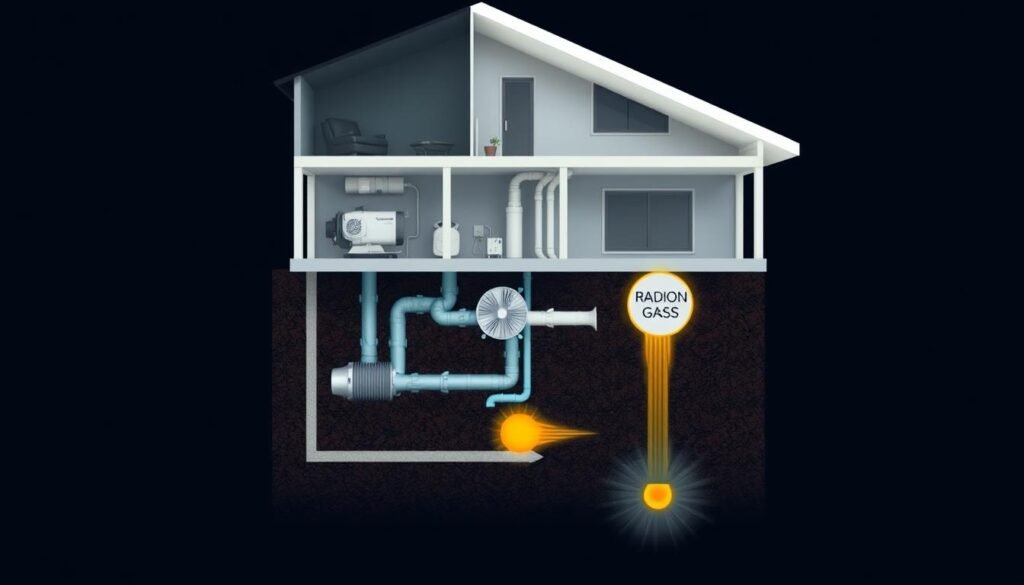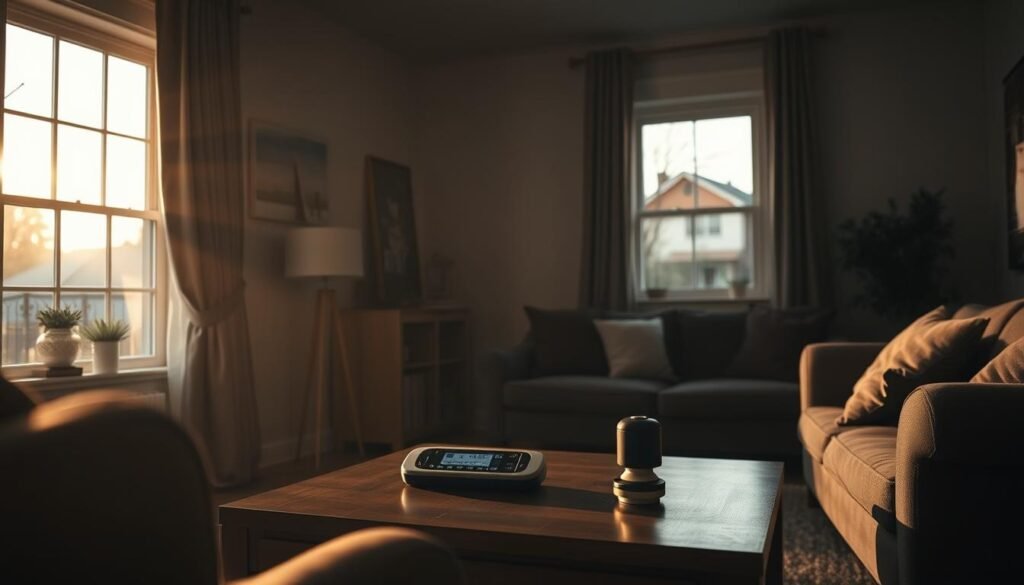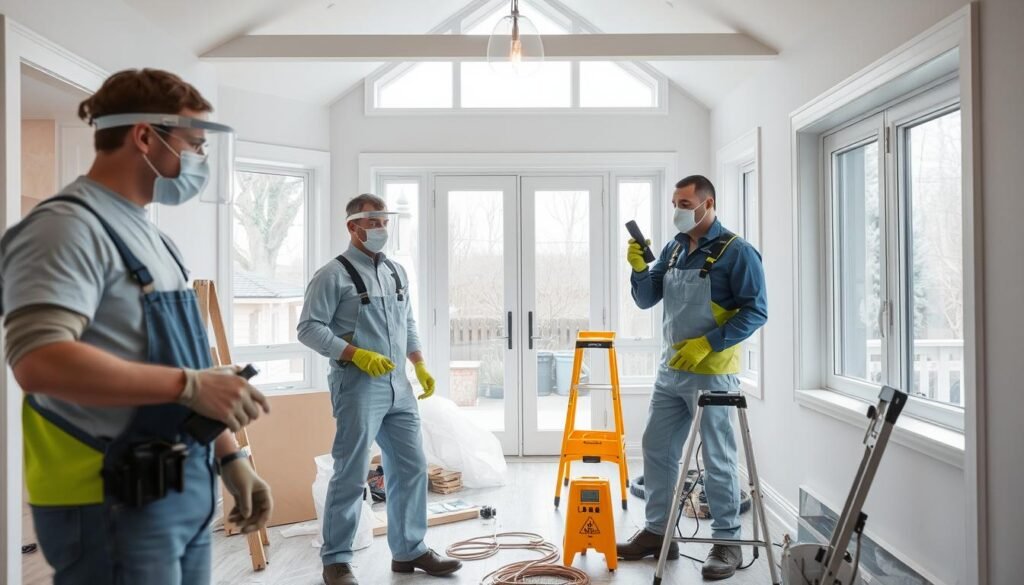The U.S. Environmental Protection Agency says radon gas exposure causes about 21,000 lung cancer deaths each year. It’s the second-biggest cause of lung cancer in the United States. Shockingly, about one in every 15 homes has dangerous radon levels. This invisible, odorless gas is a hidden danger many don’t know about.
Radon comes up from the ground into our homes, raising lung cancer risks. This is especially true for non-smokers and those who smoke. We’ll explore lung cancer radon, its dangers, and how to protect our homes and health.
Key Takeaways
- Radon gas is the second-leading cause of lung cancer in the U.S.
- Approximately 21,000 lung cancer deaths are attributed to radon exposure annually.
- Homes can have harmful levels of radon without any visible symptoms.
- Non-smokers are disproportionately affected by lung cancer caused by radon.
- Awareness and testing for radon can help mitigate health risks.
- Preventive measures can significantly lower radon levels in homes.
Understanding Radon Gas
Radon gas is a colorless, odorless radioactive gas from natural uranium decay. It’s everywhere in the earth’s crust, mixed with radium and thorium. Outside, its levels are about 0.4 picocuries per liter (pCi/L). But inside, especially in places like basements, levels can be much higher.
Radon is heavier than air, so it collects at lower levels in homes. This can be dangerous as it raises the risk of lung cancer when inhaled. Every year, 15,000 to 22,000 lung cancer deaths in the U.S. are due to radon. Shockingly, 10% of these deaths are people who never smoked.
The EPA warns to take action if home radon levels are above 4 pCi/L. Finding and dealing with radon gas is pivotal. It’s the second biggest cause of lung cancer in the U.S. after smoking. There’s also concern about its link to other cancers, like leukemia. This raises more worries about radon’s effects on health.
What is Lung Cancer Radon?
Lung cancer radon is lung cancer caused by radon gas. This invisible gas comes from the natural breakdown of uranium in soil and rocks. It’s a top indoor air pollutant. While smoking is the main cause of lung cancer, radon is next in line. It’s responsible for 3% to 14% of all lung cancer cases.
In the U.S., the EPA says radon causes about 21,000 lung cancer deaths each year. This fact highlights the danger of radon, especially for people who don’t smoke. Radon damages the lungs by releasing radiation. This significantly raises the risk of cancer. The risk varies, with factors such as building design and air flow affecting radon levels indoors.
To provide a clearer understanding of the impact of lung cancer radon, the following table illustrates some crucial statistics:
| Statistic | Value |
|---|---|
| Lung cancer as a percentage of all cancer cases (2020) | 11.4% |
| Percentage of lung cancer cases attributable to radon | 3-14% |
| Estimated annual lung cancer deaths due to radon in the U.S. | 21,000 |
| Increased risk of lung cancer per 100 Bq/m3 radon concentration | 16% |
| Increased risk for smokers exposed to radon | 25 times greater than non-smokers |
To lower lung cancer radon risks, it’s important to check radon levels at home. It also helps to use ways that cut down on radon. Knowing about radon and its dangers is key to keeping indoors safe.
How Does Radon Enter Your Home?
Radon gas is a risk because it sneaks into homes unnoticed. Knowing how radon gets inside is key to keeping safe, especially in high-radon areas.
Common Entry Points
There are several ways radon can enter your home, raising indoor levels. Major entry routes include:
- Cracks in floors and walls
- Joints where building materials meet
- Gaps in foundations
- Openings around pipes and service lines
Radon gas uses these spots to move in from the soil. Checking these spots helps stop radon from coming in and keeps your home safe.
Environmental Factors Contributing to Radon Accumulation
Many environmental factors affect radon levels in homes. Important ones are:
- Soil Types: Some soils and rocks, especially if they have uranium, make more radon.
- Building Design: Poorly ventilated homes or certain designs can trap more radon.
- Geographical Location: Some places have naturally higher radon levels, needing extra care.
Knowing these factors helps you see if your home might have radon issues. It’s a crucial step in keeping your family healthy.
Health Risks Associated with Radon Exposure
It’s important for homeowners to know about the risks of radon exposure. Radon is a radioactive gas that occurs naturally. It can build up inside, especially in areas with poor air flow, like basements. Being exposed to radon for a long time can greatly increase the chance of getting serious health problems, such as lung cancer.
Link to Lung Cancer
The connection between radon and lung cancer is strong. The US Environmental Protection Agency states radon is the second biggest cause of lung cancer in the US after smoking. About 20,000 lung cancer deaths per year are linked to radon. For smokers, the danger is even greater if radon is also present. The EPA warns that smoking combined with radon is especially harmful to lungs.
Radon Exposure vs. Other Risk Factors
Smoking is the top risk for lung cancer, but radon is the second for people who don’t smoke. Other big risks include secondhand smoke, asbestos, and pollution. These factors make it important for homeowners to be careful to keep their homes safe and healthy. Reducing radon levels and understanding the health risks are key. Testing homes regularly can help avoid the dangers of radon. For tips on how to test and lower radon levels, visit this resource.
Radon Testing Methods
Checking radon levels at home is key for health safety. There are short-term and long-term tests to find this dangerous gas. Each kind of test has its own advantage and aim in checking for radon.
Short-term Testing
Short-term tests check radon for a short time, from 2 to 90 days. They give quick results and show if there’s a radon issue. But, many things can change the results. Things like the weather and how much the house is used.
Long-term Testing
Long-term tests give a detailed look at radon over more time, from 90 days to a year. They give accurate results. They show the real level of radon in a home. This is a good choice in places with high radon levels. It helps understand and manage risks well.
Radon tests are a must when buying or selling a house, or before fixing it up. Also, before making lifestyle changes that mean spending more time in the house’s lower levels. Using both short and long-term tests makes sure radon levels are checked well. It helps in keeping cancer risks as low as possible.
| Testing Method | Duration | Typical Use | Limitations |
|---|---|---|---|
| Short-term Testing | 2 – 90 days | Initial assessment of radon levels | Less accurate; subject to fluctuations |
| Long-term Testing | 90 days – 1 year | Detailed understanding of average radon exposure | Takes longer to get results |
Mitigation Strategies for Radon
Making your home safe from radon is key. Many steps focus on better ventilation and sealing places where radon can enter. This keeps radon levels low.
Improving Home Ventilation
Better ventilation is essential for lowering radon levels. More air moving through your home means less radon. Homeowners can use different ways to get more air in:
- Installing exhaust fans in key areas.
- Opening windows to let fresh air in.
- Using special ventilation systems to fight radon.
These steps are crucial. The Environmental Protection Agency (EPA) finds that one in 15 U.S. homes has high radon. Good ventilation not only cuts radon but also improves air quality inside.
Sealing Cracks and Openings
Radon reduction also means sealing your home. Check for and seal cracks in walls, foundations, and floors. This stops radon from getting inside. Regular checks and sealing are important for keeping radon out. Use these for sealing:
- Caulk for tiny cracks.
- Expanding foam for bigger gaps.
- Concrete mix for fixing foundations.
Fixing your house and sealing cracks helps block radon. For tips on how to do this, see the EPA’s radon reduction guide.

The Importance of Early Detection
It’s crucial to tackle radon exposure in homes to lower lung cancer risks. Early detection through regular home testing can make a big difference in health and safety. Radon is the second leading cause of lung cancer in the U.S., causing over 22,000 deaths each year.
Therefore, it’s recommended to test for radon every two years, especially in high-risk areas. This can greatly reduce the danger.
Role of Regular Home Testing
Testing radon levels at home is key to spotting hazards. Kits can check the air for radon in picocuries per liter (pCi/L). If levels top 4 pCi/L, it’s critical to fix the problem quickly.
In places like North Carolina, where radon is common, testing is a must to stay healthy. Early detection lets homeowners tackle radon before it’s too late.
Seeking Medical Advice
If you’ve been around radon or worry about your lungs, get medical advice. Seeing doctors regularly helps watch for lung cancer signs and risks. The U.S. Preventive Services Task Force suggests screenings for those at high risk, like heavy smokers. Doctors might use low-dose CT scans for early lung cancer detection.
Since risks like radon are often overlooked in screenings, advice from doctors is essential for health protection.
Radon Levels and Your Home
Radon gas is a radioactive substance found in the air. Although radon levels are usually low, knowing about high levels is important. Keeping a healthy indoor environment means following health advice to avoid this invisible danger.
Understanding Safe Limits
The EPA suggests keeping radon levels below 4 picocuries per liter (pCi/L). About 1 in 15 homes might have higher radon levels. Testing often helps ensure levels are safe, and taking steps when they’re not is key.
Radon can cause between 15,000 to 22,000 lung cancer deaths a year in the U.S. It’s even more dangerous for smokers or those living in homes above the EPA’s safety level. Knowing and managing radon at home can greatly cut health risks.

To learn more about radon and how to prevent it, click here. It’s important to keep an eye on radon levels and follow guidelines to protect your family and home.
Radon and Other Lung Cancer Risk Factors
Knowing about different lung cancer risk factors is key to staying healthy and safe. Being exposed to radon and other harmful elements can make lung cancer more likely. This shows why it’s so important to look at all risk factors together.
Secondhand Smoke
Secondhand smoke is a big risk for lung cancer, causing about 30% of deaths in non-smokers. Being around radon and secondhand smoke at the same time can be even more dangerous. It’s crucial for everyone to be aware of the risks in their environment to protect their health.
Asbestos Exposure
Being exposed to asbestos greatly raises the risk of getting lung cancer. This is especially true for people who work in construction or live in older homes. Knowing about the dangers of both asbestos and radon is important for stopping lung cancer.
Genetic Factors
Genes also play a big role in lung cancer risk. Having family members who had lung cancer means you could be at higher risk, too. Even though how we live affects our health, our genes are also a big factor in lung cancer risk.
| Risk Factor | Impact on Lung Cancer Risk |
|---|---|
| Secondhand Smoke | Contributes to 30% of lung cancer deaths in non-smokers |
| Asbestos Exposure | Drastically increases risk, especially when combined with smoking |
| Genetic Factors | Family history can double the risk of developing lung cancer |
| Radon Exposure | Second-leading cause of lung cancer, particularly in non-smokers |
Precautions During Home Renovation
Home renovation projects can be tricky, especially when it comes to staying safe. Knowing about dangers like asbestos and radon is key for a healthy home. It’s crucial to use building practices that keep radon out, whether you’re building new or fixing up.
Assessing Asbestos Presence
Old buildings might have asbestos, which is really bad for your health. It’s super important to check for asbestos before starting work. If you find it, you need experts who know how to deal with it. This keeps the work area safe and lowers the risk of breathing problems.
Using Radon-Resistant Building Techniques
Adding radon-blocking features to your construction plan is smart. Things like special vent pipes and seals help keep radon out of your house. Following these steps makes your home safer and meets EPA guidelines. They say to act if radon levels hit 4 pCi/L or more.

After fixing up your place, check the radon levels again and keep checking every two years. Keeping an eye on radon helps keep your air clean and lowers lung cancer risks. You can use radon test kits to watch the levels at home. Good planning and careful checks mean you can improve your home safely.
Getting Professional Help
Dealing with radon in homes needs the right methods and expert help. If radon is a problem, hiring skilled contractors is wise. They’re trained in testing and fixing radon issues. This makes sure your home meets EPA rules and keeps everyone healthy.
Hiring Qualified Contractors for Testing and Mitigation
Choosing licensed radon contractors is key. They know how to test and fix radon problems correctly. Look for professionals who understand local laws. They should have a good history of dealing with radon. Working with these experts helps accurately check radon levels. This ensures the right steps are taken to lower risks.
Resources for Further Assistance
There are many resources for handling radon well. The EPA offers advice on testing, fixing radon issues, and understanding the health risks. Homeowners can contact local radon offices or use national services. These services connect them with the right professionals. It’s important for raising awareness and learning about radon.
Myths and Misconceptions about Radon
Radon myths often confuse people about this dangerous gas. A common misconception is that radon is only a risk in certain places. But actually, it can be a problem in homes anywhere in the country. It’s important for everyone to know that radon can affect any home.
Some think that only old homes or certain types of buildings get radon. This isn’t true. Any home, no matter when it was built or what it’s made of, can have radon. This wrong idea stops people from checking their homes for radon.
Educational campaigns are key in fighting these untrue beliefs about radon. They teach homeowners why it’s important to test their houses regularly for radon. Even homes that look safe may actually have high levels of radon.
- Radon is the second-leading cause of lung cancer in the U.S.
- Over 21,000 deaths annually relate to radon exposure.
- An estimated 1 in 15 homes has dangerous radon levels.
- Opening windows does not significantly reduce radon levels during testing.
Fighting radon myths helps people take their safety seriously and promotes healthier homes. When people know more, they are more likely to test for radon. This can lower the dangers of being around radon gas for too long.
Conclusion
Knowing the dangers of lung cancer from radon is key for a safe home. Every year, radon causes about 21,000 lung cancer deaths, says the U.S. Environmental Protection Agency (EPA). Homeowners should test for radon often and use ways to lower its levels to stay safe.
Residential radon is a big risk, so taking care of our health is a must. Testing for radon can find if levels are too high. Getting help from experts can fix the problem. This way, families can avoid the dangers of lung cancer from radon.
By being aware and acting early, families can live in safer homes. They can lower their risk by making smart health choices. Starting the fight against radon now helps protect our loved ones from lung cancer later.